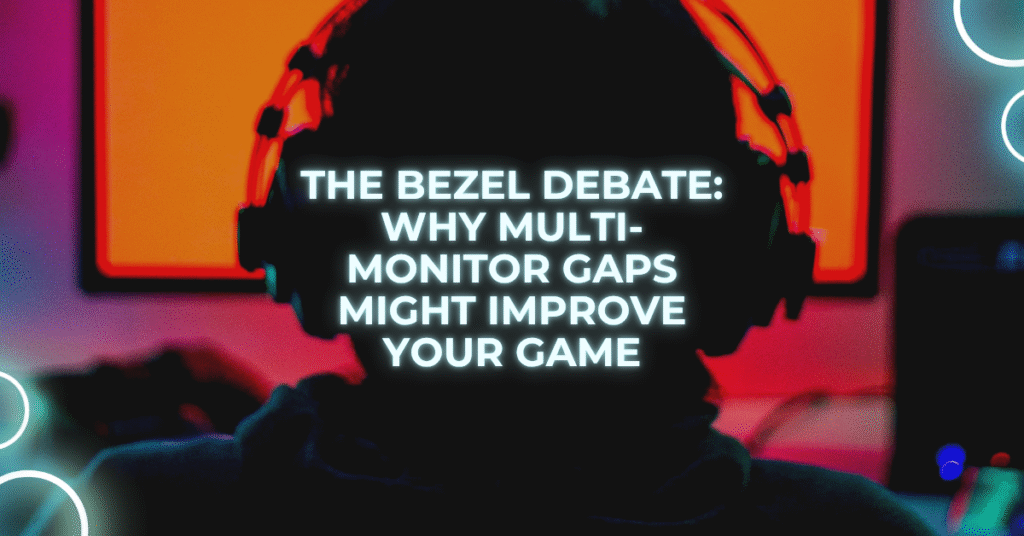Okay, let’s get this out of the way — yes, bezels are annoying. But what if I told you they might actually make you a better gamer? No, seriously. Hear me out.
You know the setup. Three monitors, edge to edge, giving you that panoramic, cockpit-like gaming view. And then bam — right between them? A big ol’ vertical black line. The bezel. It’s like a rude interruption in an otherwise immersive masterpiece.
For years, I thought bezels were the enemy. I hated them. Dreamed of going ultra-wide or investing in one of those futuristic wraparound displays. But then something weird happened: I got used to them. Not just used to — I started liking them.
So now I’m here, sipping my second cup of Tim Hortons, telling you that maybe — just maybe — those little screen gaps are actually doing your game a favour.

Problem: Everyone’s Obsessed with Seamlessness
Let’s face it — gamers are visual perfectionists. We chase frame rates like gold, tweak brightness for days, and we’ll spend hours cable-managing the back of a monitor that no one ever sees. So of course, when you slap three displays together and see those chunky black bars between them, your gut says, “Nope. That’s wrong.”
Everyone on Reddit screams about it. Streamers act like bezels are medieval torture. And those slick product ads? They photoshop them out entirely, pretending bezels just don’t exist.
But they do.
And for those of us in Canada where importing an ultra-wide can cost more than your rent in Toronto — most multi-monitor warriors are still rocking traditional screens with bezels.
So yeah. We’ve all been trained to hate them.
Agitation: Bezels Break Immersion — Or Do They?
You’ve heard it all before:
- “They ruin the visual flow.”
- “You miss critical enemy info in FPS games.”
- “It’s like driving with a windshield wiper permanently stuck in the middle.”
I used to agree. In fact, I nearly returned my second monitor after a week of trying to play Escape from Tarkov. It felt like I was losing split seconds every time I had to scan across that divide. My eyes would hop, stutter, overcorrect.
But then I noticed something… I shifted the focus to something else. In the literal sense.
Solution: Bezels as a Brain Boost?
Here’s where it gets juicy. That gap? That annoying, black void between monitors? Turns out it might actually help with focus and mental compartmentalization.
Let me explain.
Your brain — amazing as it is — doesn’t love overstimulation. When you’ve got one giant, uninterrupted field of information coming at you (especially in a high-speed game), it has to constantly scan, interpret, and sort all that noise. That takes processing power. And in twitch shooters or sim racing games, that tiny bit of delay can cost you.
But when your display is broken up by bezels, your brain treats each panel as a separate visual “zone.” It’s like your screen becomes three distinct lanes: left, center, and right.
And suddenly? You’re not scanning wildly anymore. You’re checking sectors. Your awareness becomes deliberate. Controlled.
I started calling it my “peripheral discipline.” And weirdly enough, I started playing better.
Real Talk: How It Helped My Gameplay
Let’s rewind a sec. I’m playing Flight Simulator, cruising over Alberta — snow-dusted mountains to the left, deep blue skies up front, and a storm brewing on the right.
With one huge screen, I used to panic. My eyes would dart all over. I’d miss checklist cues or botch landings. But with bezels acting as dividers, I had clearer “zones” to focus on.
- Left: instruments.
- Middle: flight path.
- Right: environmental checks.
It was like organizing my mental desktop. Same thing happened in PUBG. Once I got used to the gap, I could quickly sweep my eyes without second-guessing. I’d literally feel where danger was coming from based on which screen it entered. That kind of spatial awareness? Game changer.
The Practical Perks No One Talks About
Alright, so beyond the focus-boosting mumbo jumbo, there are some very real everyday perks to having bezels — especially in a multi-monitor setup.
- Natural eye break: That micro-pause your eyes get while moving from screen to screen? It’s actually helpful for reducing fatigue.
- Window separation: If you’re like me, gaming isn’t your only hustle. Streaming, Discord, Spotify, and OBS are all open. Bezels help mentally organize space so you don’t accidentally click the wrong window mid-recording.
- Budget and availability: Let’s not sugarcoat it — high-end ultrawides or borderless panels cost a fortune. Especially in Canada with shipping, import fees, or the classic “out of stock” sign on Best Buy’s site for three months.
- Easier maintenance: One panel dies? Just replace it. No drama.
Bonus for Canadian Gamers: Cozy Setup, Cozy Focus
It’s cold half the year. Your hoodie’s on, the kettle’s whistling, and your game room is your sanctuary. Bezels, weirdly enough, match that cozy chaos. They create structure in a space that’s already cluttered with comfort. You feel more in control, like your screen world has walls — not just endless digital space.
And hey, power goes out (hello, snowstorm season)? It’s cheaper to replace one damaged monitor than a $2,000 ultrawide.
Now, Don’t Get Me Wrong…
I’m not saying bezels are better than a perfectly seamless, 49-inch curve that wraps around your skull and whispers “immersion” in your ear. That setup slaps.
But most of us don’t have that. And that’s okay. Because if you lean into the bezel life, you might just unlock a new way to think about your display. Less distraction. More segmentation. Focus that actually sharpens over time.
And sometimes? That black line is the line between chaos and clarity.
TL;DR — Bezels Ain’t the Bad Guys
They might not be sexy. They definitely ruin screenshots. But bezels give you structure, mental zones, and—shockingly—a performance edge once your brain adapts.
Next time you glance at that vertical void between your middle and side monitor, don’t scowl. Smile. That little gap? It’s helping you stay sharp, stay focused, and maybe… just maybe… win.

Leave a Reply